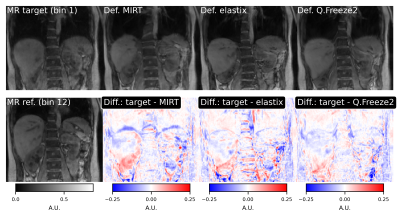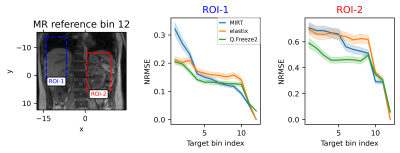Thibault Marin1, Yanis Djebra1,2, Paul Han1, Vanessa Landes3, Yue Zhuo1, Kuan-Hao Su4, Georges El Fakhri1, and Chao Ma1
1Massachusetts General Hospital, Harvard Medical School, Boston, MA, United States, 2LTCI, Telecom Paris, Institut Polytechnique de Paris, Paris, France, 3GE Healthcare, Boston, MA, United States, 4GE Healthcare, Waukesha, WI, United States
1Massachusetts General Hospital, Harvard Medical School, Boston, MA, United States, 2LTCI, Telecom Paris, Institut Polytechnique de Paris, Paris, France, 3GE Healthcare, Boston, MA, United States, 4GE Healthcare, Waukesha, WI, United States
Physiological motion during PET/MR acquisition can significantly degrade the diagnostic value of PET images. We evaluate three image motion estimation packages for kidney imaging in presence of irregular breathing motion, for application in motion-corrected PET reconstruction.

Figure 2. Comparison of registration methods. The left
column shows the MR target and reference bins. Top row images are
deformations (Def.) of the reference bin image to match the target
bin using different image registration tools. Bottom row images
represent the difference (Diff.) between the true MR target bin and
the deformed images from the top row. The Q.Freeze2 registration
results in lower residual error than MIRT and elastix.

Figure 4:
Residual error between warped and original MR bins. The left column
shows the regions of interest (ROI) considered. The center and right
columns show the normalized root mean squared error (NRMSE) as a
function of the target bin for each ROI. The shaded region around
the curves corresponds to three standard deviations, estimated via
bootstrap of the ROI pixels. Q.Freeze2 results in lower error,
especially for bins further from the reference bin (i.e. bin 12).